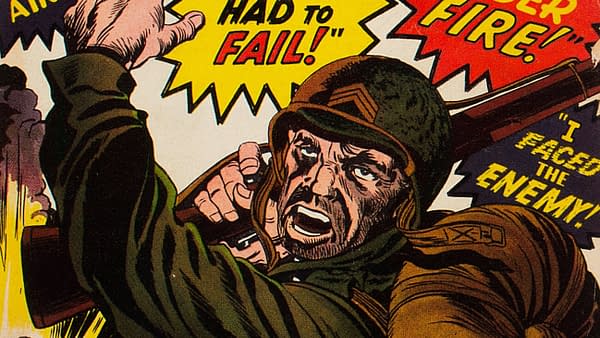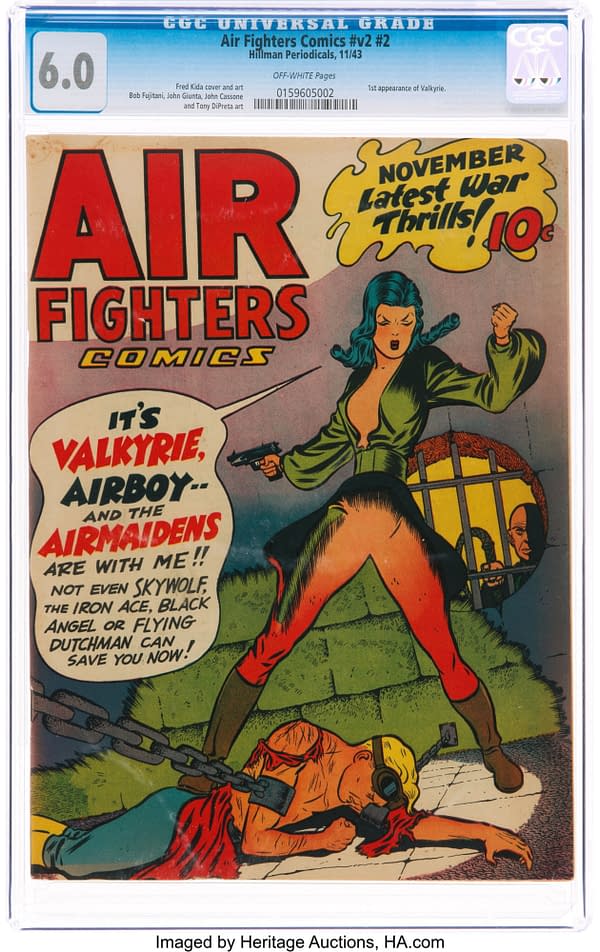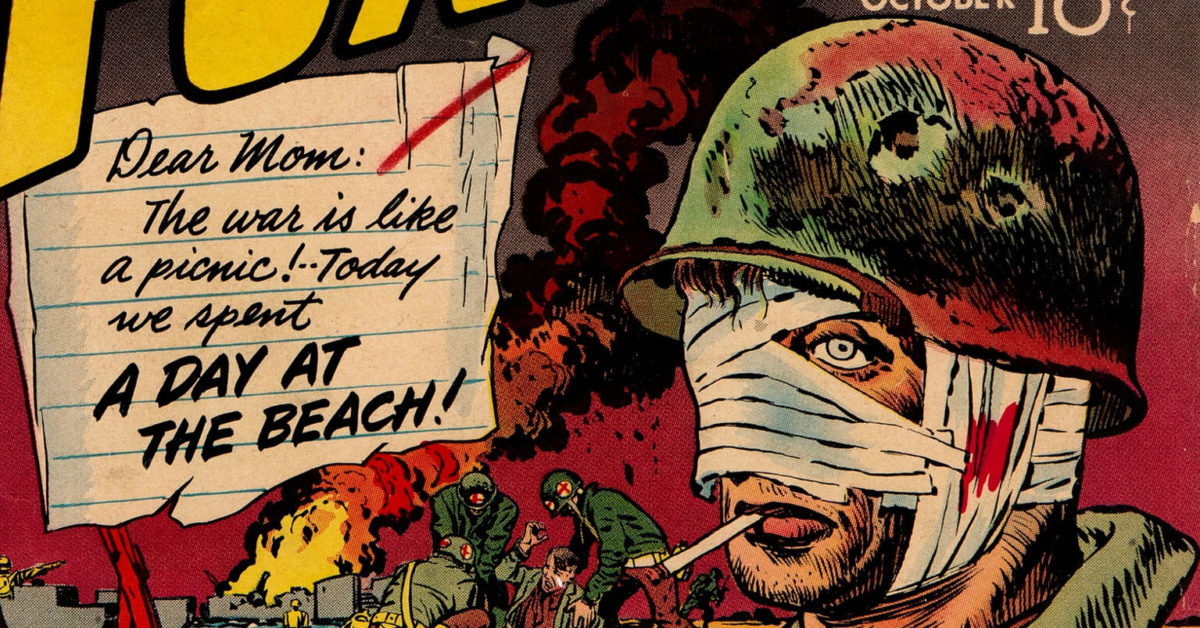Inspired by World War II, the Korean War, and the looming Cold War, the war comics of the 1940s and 1950s have a strange history behind them.
When people think of war comics as a separate thing from superheroes, 1960s-era Sgt Rock and Sgt Fury are probably the first characters that come to mind. They are the tough, savvy soldiers and leaders that fought a war that was 15+ years in the history books by the time of their arrival in comics. The creators who worked on them, many of whom had served in that war, told stories of good vs. evil not so fundamentally different from the superheroes that comprised much of the rest of the Marvel and DC Comics lines. Exceptional heroes who succeed against all odds when faced with history’s worst evils.
The genre-defining moments of the war comics that were created during the World War II and Korean War eras were also stories of good vs. evil, but their motivations were a little bit different. During World War II, for example, many publishers played an active role in the war via the efforts of the Writers’ War Board. “On paper, the Writers’ War Board (WWB) was an independent organization staffed by volunteers committed to the creation of anti-fascist, pro-American culture,” notes historian Paul Hirch. “In reality, the WWB received funding and direction from a federal agency called the Office of War Information (OWI). The WWB allowed the government to create unofficial propaganda for consumption by civilians and servicemen. Shielded by its veneer of independence, the WWB wove propaganda into popular culture to fuel a hatred of fascism, using language and images not available to propagandists openly affiliated with the government. Within the WWB there was a Comics Committee that created comic book characters and story ideas that were then passed to cooperating publishers… A publisher in good standing that printed WWB-sanctioned stories might receive access to additional wood pulp, and sell more comic books.”
Beginning in early 1943, the WWB extended its purview specifically into comic books with the creation of the Comics Committee because WWB members concluded that “the core traits of the comic book form — its broad popularity, comprehensibility, emphasis on raw emotion, and distinct lack of subtlety — marked comic books as a potentially useful delivery system for propaganda.” Several major comic book publishers worked with the WWB on a deep level — submitting story drafts, creating characters, and even developing specific story and feature ideas under the guidance of the WWB. In one specific example in this War Comics Showcase auction, Street & Smith touted the inclusion of a Writers’ War Board storyline on the cover of an issue of Air Ace. More often, such influences would go unnoted.

Along with such well-crafted heroism, the brutality and racial propaganda of some of the war comics of the era is also quite apparent, and this, too, was in large measure influenced by the WWB. In cooperation with the WWB, comic book publishers “constructed a justification for race-based hatred of America’s foreign enemies.” In their regularly-released Magazine War Guide, we can find stark examples of the WWB’s suggestions to “portray the nature of our Eastern enemies to the American people.” WWB Chairman Rex Stout exemplified the mindset of the time, which led to such portrayals with an infamous 1943 essay in the New York Times called We Shall Hate, or We Shall Fail.
After the war, the organization that had been the WWB attempted to walk back such suggestions on race-based portrayals in media, going so far as to cite DC’s All-American Comics branch as a positive example. The WWB was long gone by the onset of the Korean War, but other pressures had taken its place. For example, if a comic book publisher didn’t tell war stories in quite the “right way,” they might get banned from military bases, declared potentially subversive, and quickly investigated by the FBI.
It’s no surprise that war comics contain great heroes and great darkness, but such elements that helped shape the genre in the 1940s and 1950s are still surprisingly understudied. It’s a fascinating aspect of comic book history that is sometimes hard to look at. One collector I talked to said it was often “like the excesses of Pre-Code Horror, but sometimes far more disturbing,” which is one sense of it. The below list includes some of the notable and notorious issues in the auction according to a few serious war comic collectors. Note that some of the items shown or linked below may contain violent or otherwise offensive imagery.

- Air Ace V3 #7 – This issue features a fascinating Bob Powell cover with great composition.
- Air Fighters Comics V2 #2 – The first appearance of Valkyrie. She had very few appearances in the run, but some of the best covers. This is a classic war-era key that is still very affordable, even in nice condition.
- Battle Cry #1 – This startling Korean War-era cover introduces the series with a symbolic fight against communism.
- Battlefield #6 – This brutal masterpiece by Russ Heath features a flame-thrower cover, a recurring theme within the war genre.
- Battlefront #14 – This stunning image by Russ Heath immerses the viewer in the harsh realities of war. This copy is also the second highest graded.
- Battle #34 – A visually compelling image featuring a striking sniper cover and is currently the highest graded.
- Captain Flight NN (#1) – An incredibly rare book, and this is the highest-graded copy. “Professor X” story.
- Combat #1 – Russ Heath covers practically define the genre, and this cover helps show why.
- Exciting War #6 – A key issue for serious collectors of the genre. Flame-thrower cover.
- Fight Comics #20 – More classic Fiction House-style WWII-era war.
- Fighting Man Annual #1 – Farrell is an intriguing war publisher to collect, with a number of rare issues. This thick Annual issue is particularly interesting, and it is challenging to find it in nice shape.
- Foxhole Comics #2 – While the first issue is famed for its war cover, the cover on issue #2 is another Jack Kirby action masterpiece.
- Frogman Comics #1 – This comic is surprisingly difficult to find in nice condition. The 7.0 copy being offered is the highest graded to date.
- GI Combat #32 – Known as one of the toughest issues to find in high grade, this comic is especially interesting due to its atomic bomb cover. The cover color is dominated by vivid purples, making it one of the most distinctive in the genre. This is the highest graded copy at CGC 9.0.
- G.I. Joe #35 – Among the numerous impressive painted covers for this series up for auction, this issue is possibly the most sought-after.
- G.I Tales #4 – This is a unique war book from 1957 that is remarkably rare. This is not only the highest graded copy in census, it is the only copy.
- Marines in Battle #3 – Another noteworthy Russ Heath cover graces this issue. Its white background makes it a challenge to find in high grade, and this copy is also a River City pedigree issue.
- Men’s Adventures #20 – This issue features an epic Russ Heath cover that truly captures the threats coming from all sides of the battle. This is the highest-graded copy as well.
- Rangers Comics #21 – Interesting Fiction House cover on this issue that also featured the first appearance of Firehair.
- Spy Smasher #8 – This is a great Fawcett cover from 1942, and it’s a tough book to find in any condition.
- United States Marines #3 – This issue has one of the best-known and memorable covers in the genre.
- Victory Comics #3 – This issue has a great Bill Everett cover on a challenging, early series.
- War Adventures #5 – Russ Heath is certainly the most popular war cover artist, and this dramatic image just sums up the gritty power of his work. This copy is tied for highest graded as well.
- War Comics #11 – The black borders here often make finding well-preserved copies a challenge. This particular copy ranks among the top five graded. Perhaps the most notorious flame-thrower cover.
- War Comics #23 – A stand-out Russ Heath cover. This copy is tied for highest graded.
- War Fury #1 – One of the most desired war comics, Don Heck reused the foreground figure’s face for the cover of Horrific #3. This is one of the best graded copies available, with only two copies graded 7.5 surpassing it.
- War Report #2 – Everything from Farrell is considered tough to get, but this comic, with its flame-thrower cover, is particularly notable. The 4.0 graded copy being offered is only the second copy that Heritage has ever offered.

Affiliates of Bleeding Cool buy from and/or consign to Heritage Auctions.


